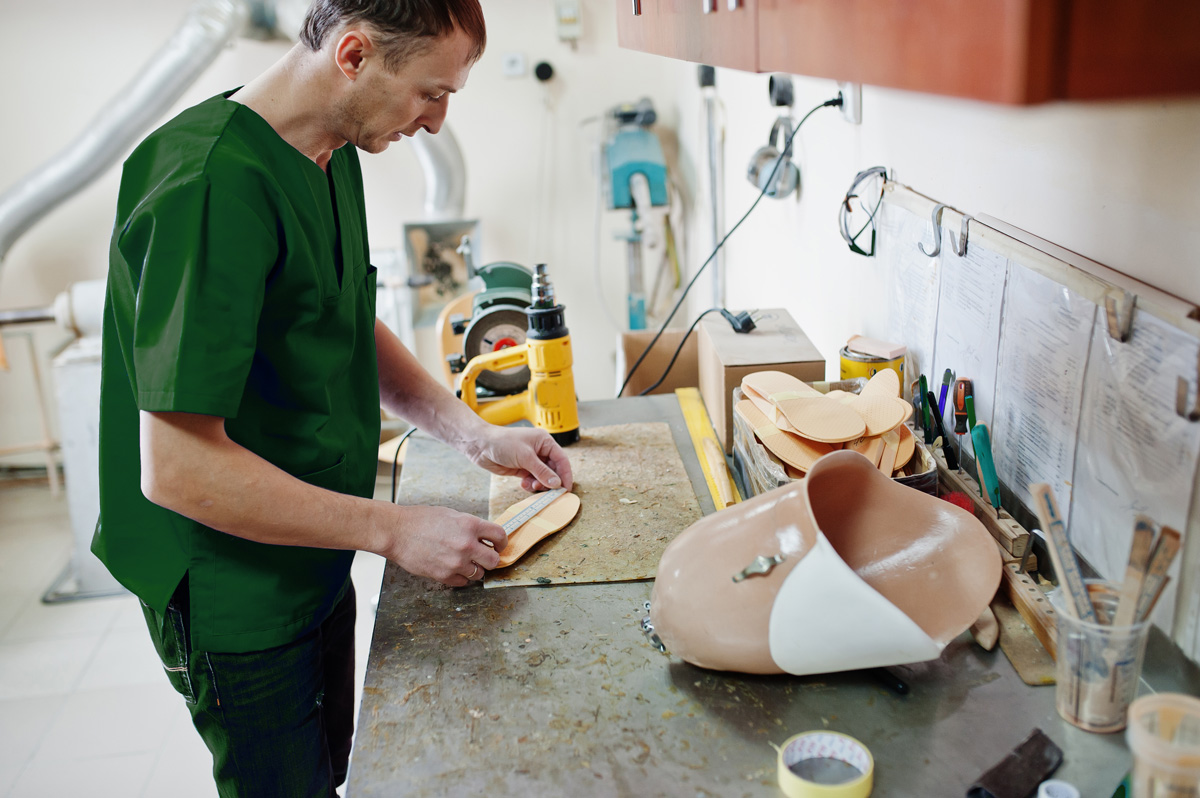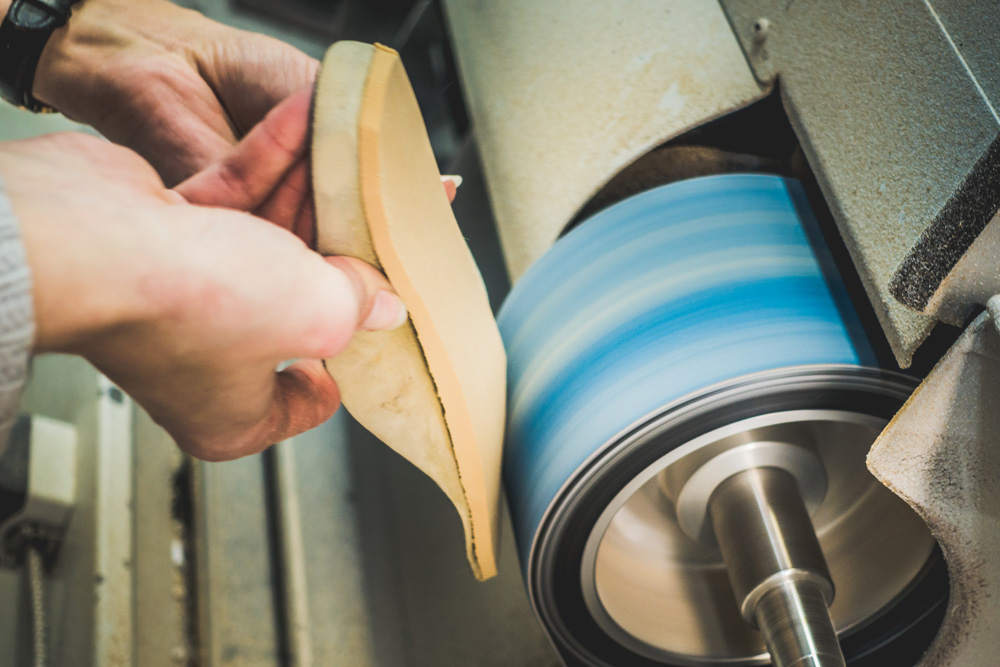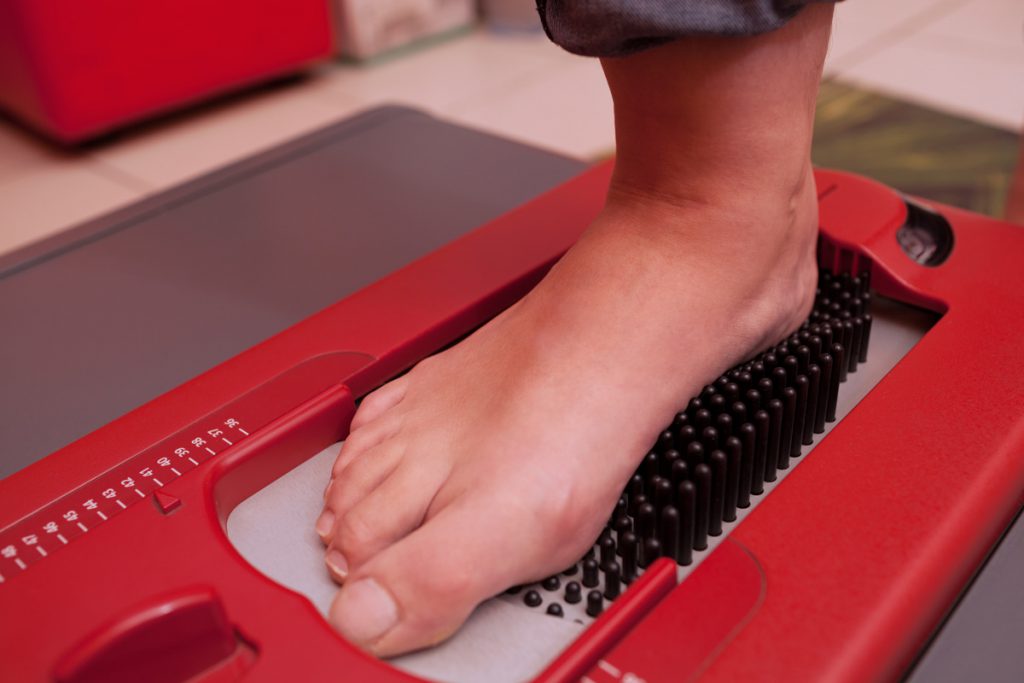
Orthotics are special heel or shoe inserts prescribed by a doctor and assessed and fitted by a Pedorthist to determine which type of orthotic to make.
Typically they are custom-made. They can help relieve back, leg, or foot pain.
Inserts vs. Orthotics
You can buy inserts in a store without a prescription. They can provide arch support and cushioning for the whole foot, around the toes, or on the heel. They are made of foam, gel, or plastic. They will not correct posture problems.
Orthotics are meant to remedy biomechanical foot issues with your gait or how you run or stand. Foot pain caused by bursitis, diabetes, arthritis, and plantar fasciitis can be relieved. In some cases, they can remedy issues with flat feet and help you avoid surgery.

Over-the-counter Options

Custom Orthotics
A doctor will prescribe custom orthotics and a pedorthist will then assess your feet and determine the best orthotic for that person. A scan, impression, or cast will be utilized to ensure the orthotic fits your foot perfectly. It will control your foot alignment and function and prevent or treat excessive rolling or another abnormal motion of the foot.
You’ll relieve calluses, pain, and discomfort by redistributing the pressure on the bottom of your feet. Custom-made orthotics will reduce the pain and increase the effectiveness of cardio activities.
Do You Really Need Them?
Orthotics are usually a component of a comprehensive treatment plan to address foot and leg discomfort and pain. Your specialist may have set the following goals for orthotic treatment.
- Helping the foot or ankle function better
- Reducing the risks of further injuries
- Correcting foot deformities
- Providing support to the ankle
Your foot specialist will typically recommend orthotics potentially in conjunction with home exercise and other forms of treatment.

How Are Foot Problems Diagnosed?
Pedorthists specialize in foot problems. You would see one if you were suffering from significant heel and foot pain. They will ask how long you’ve had these symptoms, if you ever feel relief, and what makes them worse. Then, they will perform a physical exam. They will look for particularly painful areas as well as deformities.
To see how your ankles and feet are positioned, the pedorthist will ask you to walk and do other physical activities, including special exercises. Some specialists will use special pads or imaging devices to do this examination. The images generated show where and how your feet touch the ground. They can help establish the exact type and location of problems in the function and structure of your feet.
A doctor might also recommend an X-ray or bone scan, or another form of traditional imaging. In rarer cases, they could ask you to get an MRI done, which will show soft tissue, not just bone. Imaging helps doctors identify injury, a damaged area, or conditions like arthritis.
When making a recommendation for treatment, your foot specialist or doctor should consider all of these diagnostic methods, and orthotics could be among them.
What Can Orthotics Help With?
Orthotics can be prescribed to treat several medical conditions. This section elaborates on them.
- Arthritis. Osteoarthritis and rheumatoid arthritis can result in poor posture and cause discomfort in the feet, which orthotics can help relieve or correct.
- Bursitis. This is when sacs filled with fluid develop on your toes or heels, causing pain and discomfort. It will be reduced through heel and arch support provided by orthotics.
- Diabetes. Diabetic neuropathy can lead to loss of sensation in the legs or feet. While orthotics will not treat this, they will reduce pressure and stress and prevent foot ulcers.
- Back pain. Insufficient cushioning, poor posture, etc., can cause pain that orthotics can reduce.
- Bunions. These are sensitive bumps that can grow around the big toe and result in deformities. It might help to wear orthotics with a wide toe box.
- Flat-footedness. Flat feet can cause back, ankle, and foot pain. Orthotics can promote the right foot position and provide support to the feet.
- Hammer toes. This condition comes after bunions, causing a deformity and pain in the second toe. Orthotics will prevent the worsening of the condition by providing additional support to the feet.
- Injuries. Orthotics can supplement the healing process after trauma to the ankle or foot.
- Plantar fasciitis. This is one of the most common causes of heel pain. Your doctor might recommend orthotics for foot and heel support.
- Heel spurs. A heel spur is an excessive bone growth on the bottom or back of the heel. Orthotics can reduce inflammation and support the foot.
- High arches. An excessively elevated arch can put undue pressure on foot muscles, leading to plantar fasciitis, knee pain, shin splints, and other conditions. Orthotics can keep feet from excessive rolling, outward or inward.
If you have postural issues with your legs or feet, your specialist might prescribe custom orthotics. These issues include underdevelopment or deficiency of the foot and leg muscles.
Complementary Treatments
In most cases, doctors prescribe orthotics in conjunction with physical therapy, more supportive shoes, and other treatments. To reduce inflammation and pain, they might recommend ibuprofen or another nonsteroidal anti-inflammatory drug (NSAID).
Usually, doctors prescribe several treatments at once to ensure maximum results. Orthotics can provide additional softening and support in the ball of the foot, the heel, and other key areas. In the best-case scenario, this combination of treatments can help keep the surgeon at bay.

Types of Materials Used to Make Orthotics
A wide variety of materials can be used to customize your orthotics. The material is also based on your symptoms and condition. Materials range from rigid to accommodative. Rigid orthotics are typically made of plastic or carbon fiber. Accommodative orthotics are soft and flexible.
Orthotics also vary in size. Some are only a small heel insert placed in the back of the shoe. Others cover the whole shoe and look like the inserts many athletic shoes are sold with.
There are also so-called ankle-foot orthotics, which are a combination of an insert and an upright part reaching up to the calf.
Your doctor might recommend kinesiology taping, braces, or another shoe insert along with orthotics.
Rigid orthotics are most suitable for official shoes with low heels and closed toes or walking shoes.
They are designed to alleviate foot strain and ache and reduce pain in the legs, lower back, and thighs that you might experience if you have functional foot issues.
Soft orthotics, on the other hand, will take the pressure off sore or uncomfortable areas from conditions like foot ulcers or plantar fasciitis. They tend to be bulkier than rigid ones, which is why you might have to wear them with prescription shoes.
When you get a prescription for orthotics, you should also be getting high-quality materials. With the right care, they should last for at least five years.
Do Orthotics Always Help?
Orthotics are not a panacea. They will not help every condition that can affect the ankle or foot. The following factors determine the effectiveness or lack thereof:
- the doctor’s prescription
- how often a person wears them
- the experience and training of the person making the orthotic
- the shoe in which a person wears them
When are They the Wrong Fit?
Many of the studies that confirm the effectiveness of orthotics stress that for them to work, you must wear them correctly. They have to fit well. Bend the insert to check. If you can roll it, or it bends in every spot, that means it was not made for support but for cushioning. It’s supportive if you can’t bend it in the area where the arch of the foot sits.
Custom-made orthotics, as well as over-the-counter inserts, should fit well in your shoes. Talk to your doctor if your prescription orthotics don’t sit on your feet well.

Final Thoughts
Orthotics can be an element of a comprehensive treatment plan for most people with ankle and foot problems. Orthotics can be expensive, so it’s recommended to check your insurance plan.
Want to discuss if orthotics are right for you? Contact Milton Orthotic and Wellness to speak to one of our professionals.
